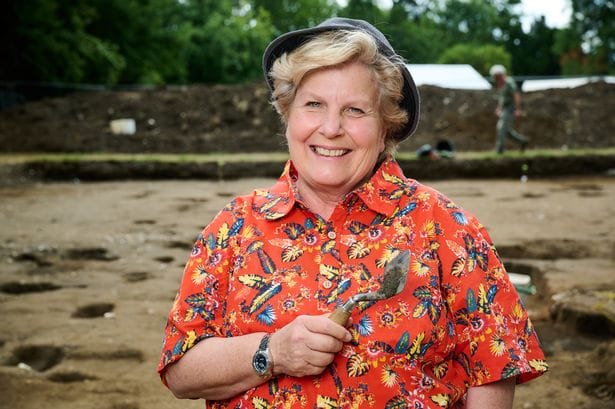Sandi Toksvig embarks on a journey across the nation as she digs out the history buried beneath our feet. But one discovery pushed her over the edge, leaving her in tears.
Sandi Toksvig is no stranger to curiosity, but in her latest series – Hidden Treasures with Sandi Toksvig – she’s delving deeper than ever before and one moment left her in floods of tears.
The beloved broadcaster is turning her lifelong love of archaeology into a full-scale adventure, uncovering the history buried beneath Britain’s soil.
“I studied archaeology many years ago at Cambridge University. It was a theoretical course, so I never went on a dig,” Sandi Toksvig says. “So when I got offered this, it was a bit that was missing in my education. I really needed to do this.”
Teaming up with her friend, archaeologist Raksha Dave, Sandi, 67, embarks on a thrilling nationwide journey across four episodes. From Dorset to Northumberland, the duo dig up remarkable discoveries that stretch from the Iron Age to the Second World War.
The series begins in Dorset, where a team from Bournemouth University excavates a 2,000-year-old Iron Age cemetery belonging to the Durotriges, one of Europe’s earliest women-centric communities.
From there, Sandi and Raksha head off to join the University of Reading at Cookham Abbey, before venturing north to explore Hadrian’s Wall and finally taking on their most ambitious dig in Essex – uncovering the wreckage of a US fighter plane from the Second World War.
READ MORE: ‘I’m a beauty writer and I tried the same hair mask Michelle Keegan swears by’
“It’s such an astonishing range,” Sandi says. “We cover everything from the Romans to the Iron Age, which is the period from about 800 BCE to 43 CE, to look at the Durotriges. They were a local Iron Age tribe in modern Dorset and one of Europe’s first women-centric communities.”
But not every discovery is easy to process. In the opener, deep in a two-and-a-half-metre pit, Sandi comes face-to-face with a haunting find.
“We discovered a 15-to-17-year-old skeleton face down with a break across one of the arms,” Sandi recalls. “The arms had been tied together prior to death. The nature of the death seemed to be violent and suggested this was perhaps a sacrificial grave. Everybody was being careful.”
Experienced and steady, Raksha handled the skeleton with care. “She very carefully picked it up and handed it to me,” Sandi says. “I turned the face at last to the light and it felt like the person was looking at me.
“At that moment, I unexpectedly burst into tears. I could not stop crying. To hold that person’s head in my hands was one of the greatest privileges of my life.”
For Raksha, the discovery was groundbreaking. “It was pretty gobsmacking,” she says. “It’s very rare to find a human sacrifice. That’s not the first one they’ve discovered, there’s an obvious pattern that follows from years of digging. This suggests that it was the norm for the Durotriges.”
The chemistry between Sandi and Raksha is a highlight of the show. “Very occasionally, you meet somebody and you think, ‘We’re going to be friends,’” Sandi says.
“I am so drawn to anybody with expertise; Raksha has archaeology running throughout her bones. She is a magnet for archaeological finds. Give that woman a trowel and stick her in a couple of inches of dirt – she’ll find you something fantastic!”
Raksha laughs, saying, “Sandi calls me a magpie because every time I turn up on the site, I find stuff.” But it’s not all glamour and golden relics. “Camera crews don’t realise how crazy it can be,” says Raksha, 48.
“There’s a lot of dirt flying around. Quite often, you can be in challenging places, not all sites are accessible. You don’t know what the weather’s going to be like, it could be really horrid and muddy.
Also, camera crews are not used to an archaeological digging timetable. When you’re down a hole shovelling into a wheelbarrow all morning, you need to have a break.”
Despite the challenges, the pair’s friendship made every trench, trowel and muddy pit worth it. “Raksha is really good fun,” Sandi says. “We had beer, sitting back in a wheelbarrow – she taught me that leaning back in a wheelbarrow is a rather comfortable chair.
We’re friends and I admire her beyond words. The fact she’s been President of the Council for British Archaeology doesn’t surprise me.” Their shared laughter balances the show’s emotional weight, but both women hope the series sparks a bigger debate about archaeology’s future.
“I hope more will volunteer. Things are beginning to rot because of climate change,” Sandi says. “The safest way to protect something was to leave it buried. Now, we need to get cracking. I would encourage everybody to volunteer. It’s a fantastic experience.”
Hidden Treasures with Sandi Toksvig airs on November 4th, on Channel 4.
Like this story? For more of the latest showbiz news and gossip, follow Mirror Celebs on TikTok, Snapchat, Instagram, Twitter, Facebook, YouTube and Threads.

